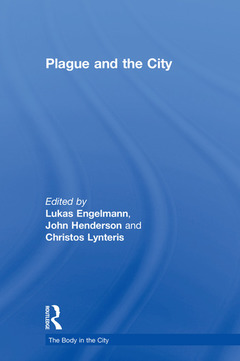Plague and the City The Body in the City Series
Coordonnateurs : Engelmann Lukas, Henderson John, Lynteris Christos

Plague and the City uncovers discourses of plague and anti-plague measures in the city during the medieval, early modern and modern periods, and explores the connection between plague and urban environments including attempts by professional bodies to prevent or limit the outbreak of epidemic disease.
Bringing together leading scholars of plague working across different historical periods, this book provides an inter-disciplinary study of plague in the city across time and space. The chapters cover a wide range of periods, geographical locations and disciplinary approaches but all seek to answer significant questions, including whether common motives can be identified, and how far knowledge about plague was based on an understanding of the urban space. It also examines how maps and photographs contribute to understanding plague in the city through exploring the ways in which the relationship between plague and the urban environment has been visualised, from the poisoned darts of plague winging their way towards their victims in the votive pictures from the Renaissance, to the mapping of the spread of disease in late nineteenth-century Bombay and photographing Honolulu?s great plague fire in 1900.
Containing a series of studies that illuminate plague?s urban connection as a key social and political concern throughout history, Plague and the City is ideal for students of early modern history, and of the early modern city and plague more specifically.
Introduction: The Plague and the City in History; Chapter 1: ‘Great Stenches, Horrible Sights and Deadly Abominations’: Butchery and the Battle Against Plague in Late Medieval English Towns; Chapter 2: Plague in Early Modern London: Chronologies, Localities, and Environments; Chapter 3: ‘Filth is the Mother of Corruption’: Plague and the Built Environment in Early Modern Florence; Chapter 4: Plague Views: Epidemics, Photography, and the Ruined City; Chapter 5: The Disease Map and the City: Desire and Imitation in the Bombay Plague, 1896-1914; Chapter 6: ‘A Source of Sickness’. Photographic Mapping of the Plague in Honolulu in 1900; Chapter 7: Public Culture and the Spectacle of Epidemic Disease in Rabat and Casablanca
Lukas Engelmann is Chancellor’s Fellow for sociology and history of biomedicine at the University of Edinburgh. His doctoral research focused on the visual medical history of AIDS/HIV. His current research focuses on the digital transformation of epidemiology and the history of epidemiological models and concepts in the long twentieth century.
John Henderson is Professor of Italian Renaissance History in the Department of History, Classics and Archaeology, Birkbeck, University of London; Fellow of Wolfson College, University of Cambridge; and Research Professor, Monash University, Melbourne. His previous publications include The Renaissance Hospital (2006).
Christos Lynteris is Senior Lecturer in Social Anthropology at the University of St Andrews and Principal Investigator of the European Research Council funded research project Visual Representations of the Third Plague Pandemic (2013–2018). His work focuses on the anthropological and historical examination of infectious disease epidemics. His previous books include The Spirit of Selflessness in Maoist China (2012), Ethnographic Plague (2016) and Histories of Post-Modern Contagion (edited with Nicholas Evans, 2018).
Date de parution : 11-2018
15.6x23.4 cm
Disponible chez l'éditeur (délai d'approvisionnement : 14 jours).
Prix indicatif 209,69 €
Ajouter au panierDate de parution : 11-2018
15.6x23.4 cm
Disponible chez l'éditeur (délai d'approvisionnement : 14 jours).
Prix indicatif 68,20 €
Ajouter au panierThèmes de Plague and the City :
Mots-clés :
Bird’s Eye; Medieval Black Death; cities; Colonial Administration; urban life; September Peak; poverty; stench; housing and dirt; Environmental Historiography; stench; Plague Pandemic; housing; Medical Geography; dirt; Early Modern London; urban environment; Sanitary Legislation; urban space; Plague Deaths; disease; Ville Nouvelle; maps; Plague Mortality; social; Early Modern Plague; ecological; Photographic Mapping; bacteriological; Bombay Plague; London; Plague Orders; Anti-plague Measures; Sanitary Surveys; Anti-plague Policies; Straw Mattresses; epidemic; Disease Maps; bubonic plague; Pozzi Neri; medieval; Early Modern Florence; early modern; Terrains Vagues; Florence; Imperial Album; Hong Kong; Spotted Fever; India; Epidemic Years; USA; scientific urbanism; public culture; butchery; urban coexistence



